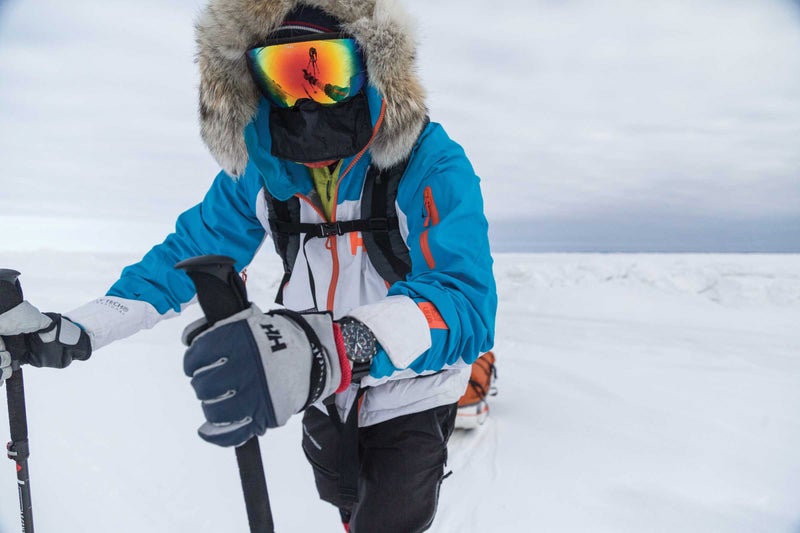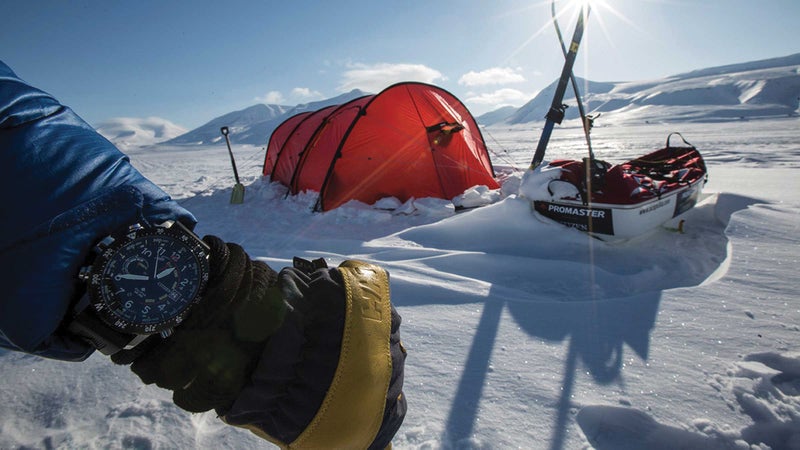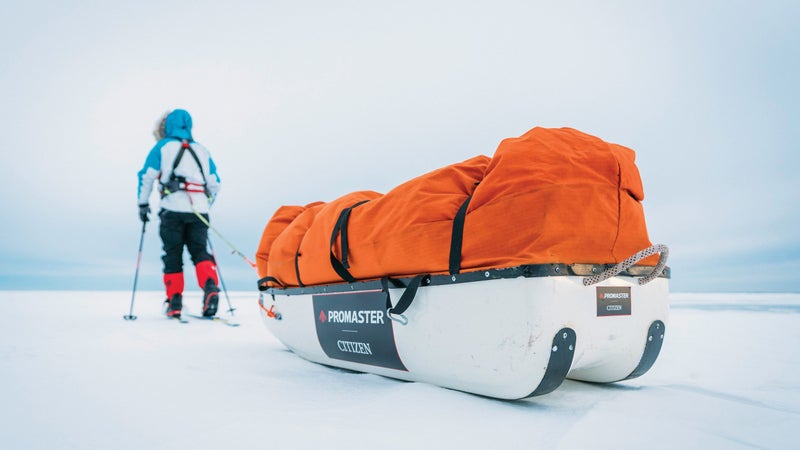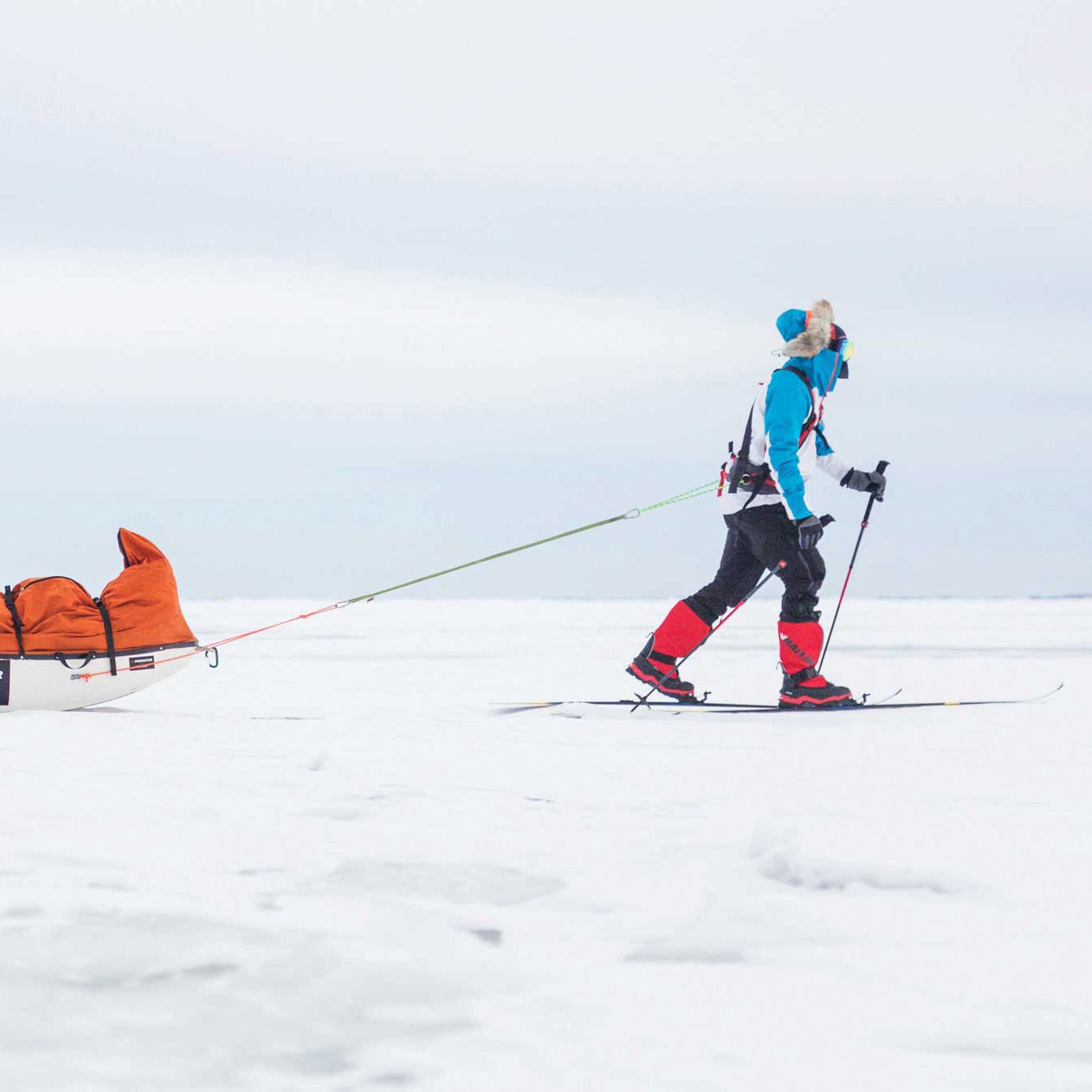Explorer Eric Larsen knows the South Pole. He’s completed more polar expeditions than any other American in history, and a few years ago he tried to ride a fat bike there. (Mushy snow derailed the bid.) Now he’s competing against the clock: this November, Eric will travel across Antarctica, roughly 700 miles from the edge of the continent to the geographic South Pole, with no resupplies or other support while attempting to break the current speed record of 24 days. Here’s how he plans to do it.
Uphill, Into The Wind
Leaving from the coast of Hercules Inlet on cross-country skis, Larsen will have to tow a 160-pound sled from sea level to 9,000 feet on snow so cold and dry it offers as much glide as desert sand. In addition to dealing with crevasses and storms, he’ll also be battling a headwind for most of the route.

Train Hard To Travel Easy
Larsen does a lot of “simulation training”—dragging a car tire filled with rocks behind him on gravel roads, for eight to twelve hours at a time. He’s also been hiking with a 60-pound backpack full of rocks.
Taking on the Norwegians
Norwegian Roald Amundsen, the first person to reach the South Pole, pulled it off (with skis and dog sleds and a support team) in three months round trip. But really it was a multi-year expedition. For his part, Larsen once guided clients to the pole in 48 days. The current solo-unsupported record is owned by another Norwegian, Christian Eide, who touched the pole in 2011 after a 24-day and 73-minute effort. “It’s not a popular Fastest Known Time record,” says Larsen. “Most people go to Antarctica to test their survivorship metal. ‘Why would I race?’ is the mindset. Eide’s record has held because it’s a hard trip.”
The current solo-unsupported record holder is Christian Eide, who completed the trip in 24-days and 73-minutes in 2011.
Extra Cheese, Please
Larsen usually consumes about 5,500 calories a day on Antarctic expeditions, but for this one, it will be closer to 8,500. That means more olive oil, cheese, and salami.
The Right Stuff
“One of the reasons I’m able to do this trip is because I know what works and what doesn’t,” says Larsen. He’s planning on taking 200 fewer pounds of gear than he normally would and only his most trusted gear—from his to the stove he’s used exclusively for years to the custom climbing-skin system he devised.

Timing Is Everything
Larsen trains and monitors his elevation gain with the and will use the —“easily one of the most bombproof pieces of gear I own”—on the actual speed attempt. Both watches can withstand extreme environments and use a lithium-ion cell that converts any type of light into energy instead of a battery. “One of the issues I came across in the past was that I had to replace the battery in my old expedition watch. Opening the back of a watch in that environment is risky—and the cold got to it. With Citizen’s Eco-Drive technology, it’s not an issue. I never have to change the battery, because the watch is powered by light.”
Larsen’s Dawn Wall
Larsen became a polar explorer to push the leading edge of adventure and to raise awareness about climate change, but for this trip he was inspired by Tommy Caldwell and Kevin Jorgeson’s 2015 quest to free climb Yosemite’s Dawn Wall in a single push. “The Dawn Wall has been climbed before, but they found a new way to make an adventure out of it. I’m applying a similar concept to the South Pole. As our knowledge increases our ability to perform at a higher level increases.”

Systems Management
“With this type of trip,” says Larsen, “it’s about traveling longer each day, not faster.” To do that, Larsen needs to preserve as much energy as possible while still being mindful of the time. Even setting up and tearing down camp becomes a NASA-like exercise in systems management. “If it takes you ten minutes to set up camp and another ten minutes to break camp,” says Larsen, “that adds up to eight hours over 24 days.”
No Blistering Pace—and No Blisters
If Larsen pushes the pace too much, he’ll risk putting himself into an energy deficit that he won’t recover from. He’s also at risk for overuse injuries like blisters. To stave those off, he’ll have to constantly monitor his form and stay balanced on his skis. “It’s easy for the machine to break down,” he says.
is an official sponsor for Eric Larsen and his LAST SOUTH expedition—sharing a concern for man’s impact on the environment and hoping to draw attention to the current state of the Antarctic ice, as well as celebrate Larsen’s 20 years of polar experience. To learn more about Larsen’s expedition, including the gear he’ll be using, or for real-time updates on his trip, visit . To shop for Citizen’s ���ǰ� visit their .

